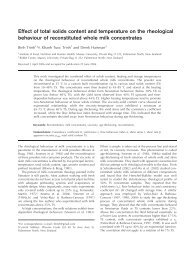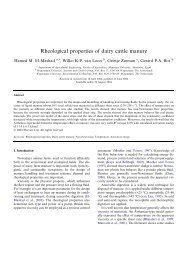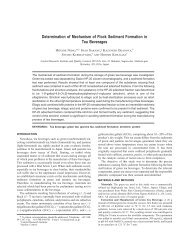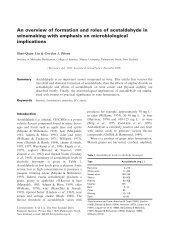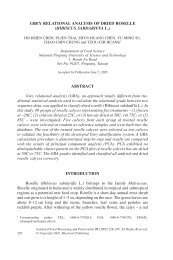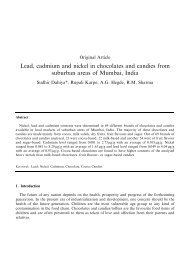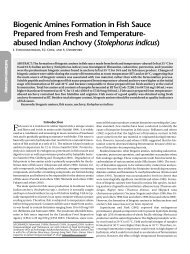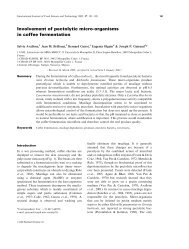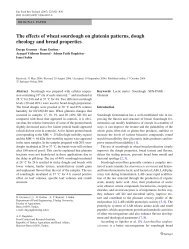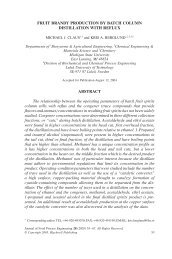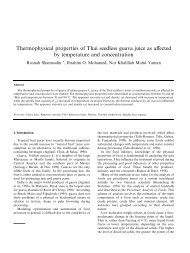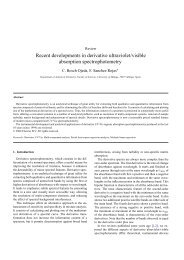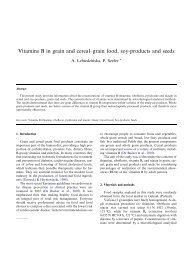Interconversions of isoflavones in soybean..
Interconversions of isoflavones in soybean..
Interconversions of isoflavones in soybean..
Create successful ePaper yourself
Turn your PDF publications into a flip-book with our unique Google optimized e-Paper software.
Is<strong>of</strong>lavones as affected by storage <strong>of</strong> <strong>soybean</strong>s . . .<br />
Food Chemistry and Toxicology<br />
t<strong>in</strong>, glycit<strong>in</strong>, daidze<strong>in</strong>, geniste<strong>in</strong>, and glycite<strong>in</strong> were purchased<br />
from INDOFINE Chemical Company (Somerville, N.J., U.S.A.).<br />
Three acetylglucosides <strong>of</strong> is<strong>of</strong>lavones, acetyldaidz<strong>in</strong>, acetylgenist<strong>in</strong>,<br />
and acetylglycit<strong>in</strong>, were purchased from LC Laboratories<br />
(Woburn, Mass., U.S.A.).<br />
Storage <strong>of</strong> <strong>soybean</strong>s<br />
Soybeans were stored under 4 conditions, <strong>in</strong>clud<strong>in</strong>g adverse<br />
conditions (84% relative humidity, 30 °C), mild conditions (57%<br />
relative humidity, 20 °C), cold conditions (4 °C <strong>in</strong> walk-<strong>in</strong> cooler),<br />
and uncontrolled ambient conditions (<strong>in</strong> a garage). Soybeans <strong>in</strong><br />
the conditions <strong>of</strong> uncontrolled ambient garage, cold condition,<br />
and 57% RH, 20 °C were stored for up to 18 mo and sampled at 3<br />
mo <strong>in</strong>tervals. Soybeans <strong>in</strong> 84% RH, 30 °C were stored for up to 9<br />
mo and sampled at 1 mo <strong>in</strong>tervals. For the uncontrolled ambient<br />
condition, <strong>soybean</strong>s were packed <strong>in</strong> a paper bag and placed <strong>in</strong> a<br />
garage without temperature control. For cold conditions, <strong>soybean</strong>s<br />
were packed <strong>in</strong> a paper bag and put <strong>in</strong>to a plastic bag (air<br />
and water impermeable type), then stored <strong>in</strong> a refrigerator (3 to<br />
4 °C). For temperature and humidity controlled conditions, <strong>soybean</strong>s<br />
(120 g) were sealed <strong>in</strong> a can (size 303 mm ´ 406 mm) which<br />
conta<strong>in</strong>ed 40 mL <strong>of</strong> saturated salt solution <strong>in</strong> a cup with a lid on<br />
which many holes were punched, and stored <strong>in</strong> a temperaturecontrolled<br />
<strong>in</strong>cubator. The saturated sodium bromide solution<br />
was used for 57% RH and 20 °C, and the saturated potassium<br />
chloride solution was used for 84% RH and 30 °C (Rockland<br />
1960). Soybeans sealed <strong>in</strong> a plastic bag and stored <strong>in</strong> –20 °C<br />
freezer was served used as the control. At the end <strong>of</strong> the storage<br />
<strong>in</strong>terval, <strong>soybean</strong>s were placed <strong>in</strong> a –20 °C freezer until analysis.<br />
Preparation <strong>of</strong> <strong>in</strong>ternal standard<br />
The <strong>in</strong>ternal standard, THB, was synthesized accord<strong>in</strong>g to procedures<br />
described <strong>in</strong> Murphy and others (1997). In a flask conta<strong>in</strong><strong>in</strong>g<br />
a mixture <strong>of</strong> 4-hydroxyphenylacetic acid (2 g) and boron trifluoride<br />
etherate (4.5 mL), resorc<strong>in</strong>ol (2.9 g) was added. This mixture<br />
was stirred and heated <strong>in</strong> boil<strong>in</strong>g water bath on a hot plate to refluxed<br />
for 10 m<strong>in</strong>. After cool<strong>in</strong>g to room temperature, 30 mL <strong>of</strong> saturated<br />
sodium acetate was slowly added to the flask, then 15 mL<br />
<strong>of</strong> saturated sodium bicarbonate were added drop by drop. The<br />
orange-yellow precipitate was filtered and washed with distilled<br />
water and then chlor<strong>of</strong>orm, and dried at room temperature under<br />
hood. The orange crystals were redissolved <strong>in</strong> 100% ethanol and<br />
purified through a Sephadex LH 20 chromatography column with<br />
50% ethanol as the eluent. A s<strong>in</strong>gle peak as determ<strong>in</strong>ed by UV detection<br />
at 262 nm was collected and freeze-dried. The THB purity<br />
was more than 99% as checked by HPLC and there was no contam<strong>in</strong>ation<br />
peak at the retention time <strong>of</strong> geniste<strong>in</strong>.<br />
Table 1—Moisture content <strong>of</strong> <strong>soybean</strong>s stored <strong>in</strong> 3 conditions<br />
for up to 18 mo 1<br />
57% RH Cold Ambient<br />
Month 20 °C 4 °C Condition Condition<br />
0 5.40 ± 0.01 b 5.40 ± 0.01 e 5.40 ± 0.01 c<br />
3 9.37 ± 0.03 a 8.18 ± 0.05 d 8.82 ± 0.01 b<br />
6 9.65 ± 0.44 a 8.99 ± 0.05 c 8.94 ± 0.05 b<br />
9 9.36 ± 0.06 a 9.38 ± 0.02 b 9.00 ± 0.06 b<br />
12 9.74 ± 0.06 a 9.81 ± 0.00 a 9.40 ± 0.06 a<br />
18 9.79 ± 0.02 a 9.41 ± 0.11 b 8.87 ± 0.17 b<br />
1 Data were expressed as means ± sd <strong>of</strong> triplicate and <strong>in</strong> the same column<br />
with different superscripts are statistically different at P £ 0.05.<br />
sample solution was filtered aga<strong>in</strong> through a 0.20 mm PTFE (polytetrafluoroethylene)<br />
membrane filter (Nalge Nunc International<br />
Corp., Rochester, N.Y., U.S.A.) and analyzed by HPLC with<strong>in</strong> 10 h<br />
after extraction to m<strong>in</strong>imize the conversion <strong>of</strong> malonylglucosides<br />
to glucosides (Murphy and others 1999). Each sample was extracted<br />
<strong>in</strong> duplicate.<br />
Is<strong>of</strong>lavone analysis<br />
The quantitative analysis <strong>of</strong> <strong>soybean</strong> is<strong>of</strong>lavones was performed<br />
by HPLC accord<strong>in</strong>g to Murphy and others (1997) with a slight modification.<br />
A Waters Associates (Milford, Mass., U.S.A.) chromatography<br />
system equipped with a Model 720 system controller, Model<br />
6000A solvent delivery system, Model 7125 load<strong>in</strong>g sample <strong>in</strong>jector,<br />
and Model 418 LC spectrophotometer set at 262 nm was used. A<br />
YMC-pack ODS-AM-303 C 18 reversed phase column (5 mm, 250<br />
mm ´ 4.6 mm <strong>in</strong>ternal dia) was obta<strong>in</strong>ed from Waters and employed<br />
for chromatographic separations at 34 °C, which was ma<strong>in</strong>ta<strong>in</strong>ed<br />
with a column heater. A l<strong>in</strong>ear gradient mobile phase consisted <strong>of</strong><br />
solvent A (0.1% acetic acid <strong>in</strong> water) and solvent B (0.1% acetic acid<br />
<strong>in</strong> acetonitrile). After <strong>in</strong>jection <strong>of</strong> 10 mL <strong>of</strong> sample, the system was<br />
eluted with 15% <strong>of</strong> solvent B for 5 m<strong>in</strong> at the flow rate <strong>of</strong> 1.0 mL/m<strong>in</strong>,<br />
then <strong>in</strong>creased to 29% <strong>in</strong> 31 m<strong>in</strong> at the flow rate up to 1.5 mL/m<strong>in</strong>,<br />
and then to 35% <strong>in</strong> 8 m<strong>in</strong> at the same flow rate <strong>of</strong> 1.5 mL/m<strong>in</strong>. Then<br />
the gradient <strong>in</strong>creased to 50% <strong>of</strong> solvent B for 10 m<strong>in</strong> at the flow rate<br />
<strong>of</strong> 1.5 mL/m<strong>in</strong> prior to recycl<strong>in</strong>g back to 15% B at the flow rate <strong>of</strong> 1.0<br />
mL/m<strong>in</strong> at zero time. Each sample conta<strong>in</strong><strong>in</strong>g standards was separated<br />
and analyzed at least <strong>in</strong> duplicate.<br />
Quantification <strong>of</strong> is<strong>of</strong>lavones<br />
Is<strong>of</strong>lavone quantification was performed by calculat<strong>in</strong>g the<br />
peak area obta<strong>in</strong>ed from HPLC analyses. Aglycones, b-gluco-<br />
Extraction <strong>of</strong> is<strong>of</strong>lavones<br />
The <strong>soybean</strong>s were ground with a Tekmar (A-10) Analytic Mill<br />
to pass through a 60-mesh sieve. Moisture content was measured<br />
by a vacuum oven method (AOAC 925.09 1990). Is<strong>of</strong>lavones<br />
were extracted by modify<strong>in</strong>g the method <strong>of</strong> Murphy and<br />
others (1997). One mL <strong>of</strong> <strong>in</strong>ternal standard (THB, 1.25 mg/mL)<br />
was added to 1 g <strong>of</strong> <strong>soybean</strong> flour <strong>in</strong> a screw-top centrifuge tube,<br />
and mixed thoroughly for 20 m<strong>in</strong>, then add<strong>in</strong>g 5 mL <strong>of</strong> acetonitrile,<br />
1 mL <strong>of</strong> 0.1N HCl, and 3.5 mL <strong>of</strong> distilled water. The mixture<br />
was stirred for 2 h at room temperature. Then the slurry was centrifuged<br />
at 6000 g for 20 m<strong>in</strong>. The supernatant was filtered<br />
through Whatman No. 42 filter paper <strong>in</strong>to a 125 mL flask and taken<br />
to dryness on a rotary evaporator at < 35 °C. The residues <strong>in</strong><br />
the flask were dissolved <strong>in</strong> 10 mL <strong>of</strong> 80% methanol and kept <strong>in</strong> a<br />
freezer (–20 °C) for less than 10 h before analysis. An aliquot <strong>of</strong><br />
Figure 1—Moisture <strong>of</strong> <strong>soybean</strong>s stored <strong>in</strong> 84% RH and 30 °C<br />
for 9 mo. Column with different letter is significantly (p <<br />
0.05) different.



